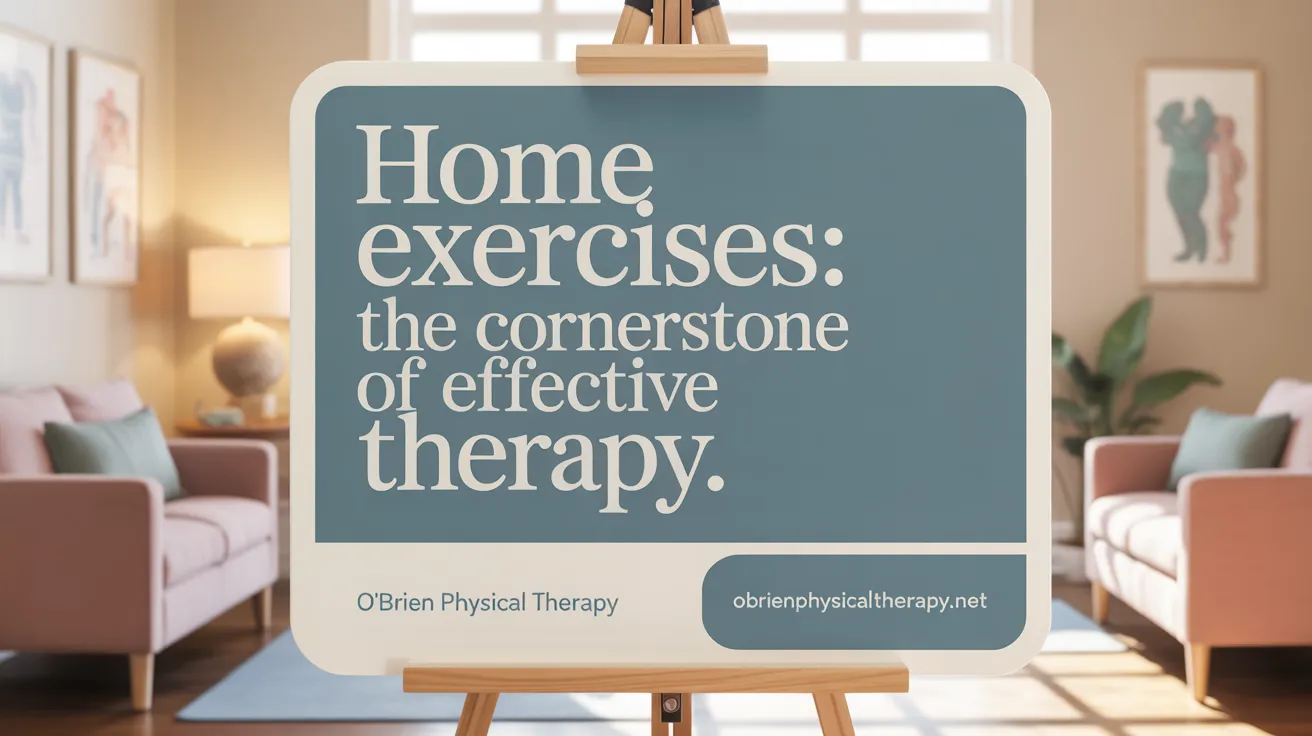Understanding Home Exercise Programs in Recovery
Home exercise programs (HEPs) stand as a cornerstone in physical therapy and rehabilitation, offering patients a personalized pathway to healing, strength, and long-term wellness beyond clinical settings. This article explores the significance of HEPs in recovery, their benefits, adherence factors, and the role of digital tools in enhancing patient outcomes.
The Vital Importance of Home Exercise Programs in Physical Therapy

What is a home exercise program?
A home exercise program (HEP) is a personalized set of therapeutic exercises prescribed by a physical therapist or specialist. These exercises are designed to be performed at home and tailored to a patient's specific injury, diagnosis, and functional needs. Typically including stretching, strengthening, balance, and functional movements, HEPs aim to promote healing, improve mobility, and prevent future injuries.
Each plan is customized, taking into account the patient's condition, progress, and goals. They are usually concise, taking 10-20 minutes daily or several times a week, and are regularly modified to match recovery stages.
How do home exercise programs aid in recovery?
HEPs play a crucial role in supporting rehabilitation outside clinic hours. Consistent participation accelerates progress, reduces pain, and improves movement quality. By reinforcing exercises learned during therapy sessions, HEPs help maintain gains, prevent deterioration, and promote long-term health.
Adherence to these programs ensures that therapy benefits are sustained, leading to faster recovery times and reducing the risk of re-injury or chronic issues. They also foster patient independence, enabling individuals to manage their rehabilitation actively.
Why are customization and gradual progression important?
Each HEP is tailored to the individual's needs, with exercises selected based on initial assessments. Proper form and correct intensity are emphasized, while programs are advanced gradually to challenge the patient and prevent setbacks.
Progression might include increasing repetitions, adding resistance, or complexity of movements. This gradual escalation encourages continuous adaptation, strength gains, and improved flexibility without risking strain or injury.
What is the significance of patient education and motivation?
Educating patients about the purpose and benefits of their HEP fosters understanding and engagement. Clear instructions, visual demonstrations like videos, and ongoing feedback from therapists enhance confidence and ensure exercises are performed correctly.
Motivation is maintained through goal setting, tracking progress, and celebrating milestones. When patients understand how exercises directly contribute to their recovery, adherence improves, making the program more effective.
How do digital platforms support adherence?
Digital tools such as apps and remote monitoring platforms facilitate ongoing engagement. Platforms like Limber and MedBridge provide instructional videos, progress tracking, reminders, and communication channels with healthcare providers.
Connected health technologies can also include wearable sensors, such as inertial measurement units (IMUs), which objectively monitor exercise adherence and quality. Moreover, features like coaching, education modules, and social forums help sustain motivation and accountability.
Employing these digital solutions has been shown to significantly boost adherence rates, which range between 35% and 67% in studies, though actual figures may vary. Improved compliance through technology translates to better clinical outcomes, reduced recovery times, and higher patient satisfaction.
In summary, home exercise programs are fundamental to effective physical therapy. Personalization, patient education, motivation strategies, and digital support systems collectively ensure that therapy benefits are maximized, leading to safer and more successful recoveries.
Benefits and Functional Impact of Adherence to Home Exercise Programs

What are the benefits of adhering to a home exercise program for recovery success?
Following a personalized home exercise plan significantly enhances recovery by improving strength, stability, and mobility. When patients participate regularly, typically three to five times weekly, they experience better management of pain, increased functional capacity, and overall improved quality of life. Digital tools like the Limber app aid adherence by tracking progress, offering educational content, and maintaining communication with healthcare providers, which boosts motivation.
Consistent exercise not only supports immediate recovery but also contributes to long-term health benefits. It reduces the risk of re-injury, flare-ups, and chronic conditions such as osteoarthritis and balance deficits. By tailoring exercises to individual needs, therapists help patients build confidence and independence, making adherence more manageable and rewarding.
Nonadherence can delay recovery, decrease satisfaction, and increase the likelihood of persistent problems. Therefore, integrating structured routines into daily life, reinforced with digital support, is essential for maximizing recovery outcomes.
What role do home exercise programs play in facilitating healing, rehabilitation, and recovery outcomes?
Home exercise programs (HEPs) are central to ongoing rehabilitation, especially after surgeries like hip fractures. Research shows that structured, functionally oriented exercises performed at home can lead to significant improvements in mobility, balance, and daily functioning, often lasting well beyond the active intervention phase.
These programs allow patients to continue their healing process independently, promoting muscle rebuilding, coordination, and confidence in movement. They are particularly vital for older adults and individuals with mobility challenges, as they support early post-operative mobility and help prevent complications.
By regularly engaging in tailored exercises, patients can achieve sustained functional gains, expedite healing, and reduce reliance on continuous in-clinic therapy. This ongoing activity encourages a shift towards an active lifestyle, ultimately leading to better overall recovery outcomes and greater independence.
Common Home Exercise Routines and Their Effectiveness in Recovery

What types of home exercise routines are commonly implemented, and how effective are they in the recovery process?
Home exercise routines in recovery commonly include a variety of exercise types tailored to individual needs and goals. These routines often comprise stretching exercises to enhance flexibility, muscle strengthening to rebuild strength, balance activities to improve stability, and aerobic exercises such as walking, cycling, swimming, or running to boost cardiovascular health.
Practices like yoga, tai chi, and dance are also incorporated for mindfulness and mental well-being. These routines are designed to target specific recovery aspects, such as reducing pain, increasing range of motion, and restoring functional capacity. In fields like physical therapy and addiction recovery, these exercises play a vital role in improving muscle strength, flexibility, endurance, and mental resilience.
When performed correctly and consistently, they significantly contribute to functional improvements and pain reduction. Techniques like foam rolling and active recovery activities support tissue healing and flexibility. Personalized routines, developed with guidance from healthcare providers or through digital tools, ensure safety and effectiveness.
Modern technology, including apps and wearable sensors, enhances adherence by tracking progress, providing instructions, and offering feedback. Overall, these routines are proven to help increase endorphin levels, improve circulation, reduce stress, and support overall health, making them crucial components of a comprehensive recovery plan.
Understanding and Enhancing Exercise Adherence in Home Programs

What is exercise adherence, and why is it critical for recovery?
Exercise adherence refers to how well individuals stick to their prescribed workout routines over time. Consistently performing these exercises is essential because it maximizes the benefits achieved during therapy, such as pain relief, improved mobility, and increased strength. When patients adhere to their home programs, they reduce their risk of setbacks, re-injury, and chronic issues.
Maintaining motivation can be challenging, but factors like enjoying the activity, setting realistic goals, and establishing routines help promote ongoing commitment. Support systems, whether through family, peers, or digital tools, also play a vital role.
By following through with prescribed exercises, patients can sustain improvements, enhance their independence, and foster long-term health benefits, making adherence a cornerstone of effective rehabilitation.
What factors predict adherence to home exercise programs in physical therapy?
Several personal and contextual factors influence how well a patient sticks to their home exercise plan. Motivation and belief in their ability—known as self-efficacy—are strong predictors.
Understanding the benefits of exercises through clear education and communication with therapists motivates patients to engage consistently. Exercises that are enjoyable, manageable, and tailored to individual needs further promote compliance.
Barriers like pain, fatigue, depression, and forgetfulness can hinder adherence, while support from therapists, family, and social networks provides encouragement.
Additionally, technological tools such as reminders, progress-tracking apps, and self-monitoring devices can help reinforce routine and accountability. An initial assessment of the patient's health status, habits, and readiness to change ensures that the program is suited to their capabilities and circumstances, leading to improved adherence outcomes.
Strategies to improve adherence including education and support
Enhancing adherence begins with proper education—patients need to understand why exercises are important and how they contribute to recovery. Clear instructions using videos or demonstrations improve comprehension.
Setting realistic goals and breaking exercises into manageable parts prevent feelings of overwhelm and increase motivation. Regular follow-up, whether through in-person visits or digital communication, maintains accountability.
Offering positive reinforcement and emphasizing small progress boosts confidence and commitment. Social support communities, whether virtual or in-person, foster accountability and shared experience.
Therapists should personalize programs based on individual preferences and lifestyle, making exercises feel relevant and achievable.
Role of connected health technology and digital reminders
Connected health solutions, such as apps and wearable devices, significantly support adherence. Features like reminders prompt patients to perform exercises at scheduled times, reducing forgetfulness.
Digital platforms can track progress, provide instant feedback, and send motivational messages, creating a sense of accomplishment.
Apps like MedBridge or Limber include educational videos, progress dashboards, and direct communication channels with healthcare providers, making it easier for patients to stay engaged.
Remote monitoring allows therapists to observe adherence patterns and intervene when necessary, improving overall program effectiveness.
Incorporating these technologies fosters an environment of continuous support and accountability, empowering patients to take an active role in their recovery.
Leveraging Digital Tools and Support Systems to Maximize Home Exercise Program Success

What types of digital tools and platforms are available?
Digital technology offers various tools to support home exercise programs. Apps like MedBridge and Limber provide exercise videos, detailed instructions, progress tracking, and patient education materials. Wearable devices and inertial measurement units (IMUs) can objectively monitor movement and adherence, providing real-time data to both patients and clinicians. Telehealth platforms enable remote consultations, ongoing feedback, and tailored guidance, seamlessly integrating with other digital supports.
What features improve motivation and engagement?
Key features that foster motivation include goal setting, reminders, visual progress charts, and educational content explaining exercise benefits. Interactive elements such as game-like challenges and social forums encourage users to stay committed. Personalization is vital, tailoring programs to individual needs and preferences, especially for tech-savvy patients who are comfortable using smartphones and tablets. These elements make the exercises more engaging and meaningful, increasing the likelihood of consistent participation.
How does remote monitoring and communication support adherence?
Remote monitoring tools like IMUs and motion capture systems enable clinicians to track exercise performance outside of clinic visits. This real-time data allows for timely feedback, adjustments, and reinforcement, which heightens clients' sense of accountability. Regular communication through messaging, video calls, or app notifications helps address concerns, troubleshoot issues, and maintain motivation. This ongoing support diminishes the gap between therapy sessions, fostering a sense of continuous care.
What is the impact on adherence and long-term outcomes?
Studies show that digital tools significantly improve adherence rates, with some reaching 67% or higher compared to traditional methods. Enhanced adherence correlates with better clinical outcomes, such as decreased pain, improved mobility, and faster recovery. Continuous engagement through these tools can sustain motivation long-term, reducing the risk of relapse or injury recurrence. While initial gains are promising, ongoing research is needed to confirm sustained benefits over many years.
Examples like Limber and MedBridge apps
Platforms such as Limber utilize apps like MedBridge to deliver comprehensive digital HEPs. MedBridge offers extensive exercise libraries, educational videos, and progress tracking, all accessible through user-friendly interfaces. Therapists can customize programs, send updates, and monitor adherence remotely. These tools help patients understand their exercises, perform them correctly, and stay motivated, translating into improved recovery rates and higher satisfaction.
| Digital Tool | Main Features | Supporting Evidence | Potential Benefits |
|---|---|---|---|
| Limber app | Videos, progress tracking, clinician communication | Improved adherence, patient engagement | Faster recovery, better outcomes |
| MedBridge | Custom exercises, education, remote monitoring | Enhanced compliance, patient confidence | Increased independence, symptom management |
| Wearable devices | Real-time movement data, feedback | Objective adherence measurement | Accurate progress tracking |
| Telehealth platforms | Virtual consultations, coaching | Continuous support, correction of exercises | Sustained motivation, accountability |
Incorporating these digital systems into home exercise regimens enhances adherence by making exercise routines more accessible, engaging, and supported. This integration translates into more successful rehabilitation, fewer setbacks, and improved long-term health.
Sustaining Recovery Through Home Exercise Programs
Home exercise programs are indispensable tools in the rehabilitation process, bridging the gap between clinical care and independent patient management. Their personalized design, comprehensive scope covering strength, mobility, and balance, and integration of digital supports empower patients to take active roles in their recovery journey. Success hinges on adherence, which can be encouraged through education, motivation, social support, and modern technology. By embracing home exercise programs, patients not only accelerate their healing but also build long-term resilience, reduce risks of re-injury, and cultivate healthier lifestyles. Ultimately, HEPs symbolize an essential investment in sustained recovery and wellness beyond the therapy room.
References
- The Benefits of Staying Consistent with Your At-Home Physical ...
- Patient Involvement With Home-Based Exercise Programs
- Why Your PT Home Exercises Are Vital for Your Recovery
- The Importance of Home Exercise Programs | Maven Stories
- 5 Benefits of Exercise in Addiction Recovery
- The Importance of Home Exercise Programs in Outpatient Rehab
- The Importance of the Home Exercise Program
- The All-important Home Exercise Program
